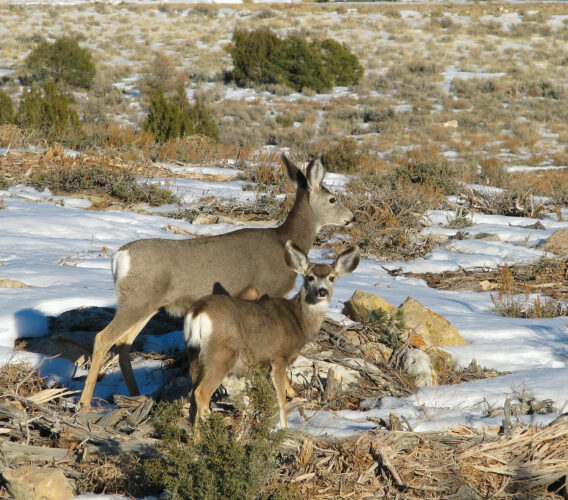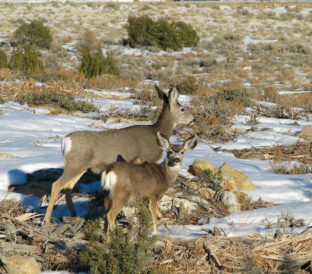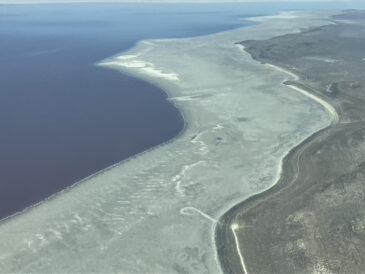Doe woes: DWR seeks public input to help boost declining deer population

Photo supplied, Mike Keller/Utah Division of Wildlife Resources
A doe and fawn mule deer forage in former chaining in Carbon County.WILLARD — As part of an effort to bolster declining mule deer populations statewide, the Utah Division of Wildlife Resources will be holding a series of meetings to gather feedback and ideas from the general public. The first meeting is scheduled for 6 to 8 p.m. on Thursday at the Willard City Multi-Purpose Building, located at 80 W. 50 South in Willard.
According to the DWR, Utah’s 2024 post-hunting season deer population estimate was approximately 295,200 animals, or 73% of the long-term management objective of 404,900 deer.
DWR Big Game Program Coordinator Dax Mangus told the Standard-Examiner that extreme weather conditions across the state have impacted deer populations, prompting his agency to engage the public and other stakeholders to help identify potential solutions.
“We’ve been here before. We had some big dips after a really harsh winter in the ’80s. We’ve been in that ballpark … that mid-200,000s range, but that’s quite low,” Mangus said. “We’re 100,000 deer below where we’d like to be right now, and a lot of that is we had a lot of winter loss after that winter of 2022-2023. Then, we’ve had drought conditions in the southern half of the state that have slowed productivity and slowed population growth.”
Although the DWR regularly holds meetings focusing on buck hunting, season dates and the number of hunting permits to be issued, Mangus said that ensuring the survival of does and fawns in particular will be the focus of the upcoming meetings.
“We don’t have a lot of public meetings where we talk about strategies for growing overall deer populations. Like, how do we grow more does? How do we grow more fawns?” Mangus said. “People are passionate about deer in Utah. So, our director sat down with a bunch of us in the agency and said, ‘Hey, let’s get together with folks from across the state and hear what they have to say and give them a chance to talk with us and share ideas.'”
Mangus noted that the DWR currently has a number of programs designed to aid deer populations, including a watershed restoration initiative with federal land management agency partners, habitat restoration and improvement projects, mitigation for development-related impacts and predator population management.
Additionally, some deer are given GPS collars and are closely monitored to assess their health and potential risk factors. When one of these animals dies, DWR receives a notification, after which a field necropsy is performed to determine the circumstances leading to its death.
“We can see habitat use and movements, migration corridors, timing of movements — all that kind of stuff,” Mangus said. “One of the things we do is, when we have those animals in hand, we take blood samples and a bunch of measurements on the deer and do a health assessment. So, we can learn a lot about what’s going on in the landscape just from what we see in those deer.”
In addition to weather factors, Mangus said that predators may be playing a role in the falling deer population.
“Predator populations often follow prey populations, but there can be a delay,” Mangus said. “So, I think right now on some of those units in Northern Utah, we still have pretty high cougar numbers based on what was previously a higher deer population. … We’re seeing several populations throughout the state where predator numbers might not have driven the population down, but they’re holding it down from bouncing back.”
As the DWR works to bring the statewide deer population back to an optimal level, Mangus invited anyone interested in helping to attend an upcoming meeting.
“We have a lot of information and we know that there are a lot of passionate folks out there that also have ideas,” Mangus said. “There might be a family that’s hunted the same canyon for deer for three or four generations, and they might have some insights or some ideas that, perhaps, our staff doesn’t have or doesn’t know. So, we just want to find ways to work together.”
The upcoming meeting schedule is as follows:
- Thursday from 6-8 p.m. at Willard City Multi-Purpose Building, 80 W. 50 South in Willard
- Aug. 12 from 6-8 p.m. at the Price DWR Office, 319 N. Carbonville Road in Price
- Aug. 14 from 6-8 p.m. at The Hideout Community Center, 648 S. Hideout Way in Monticello
- Aug. 14 from 6-8 p.m. at the Amber Room of the Mountain America Museum of Ancient Life at Thanksgiving Point, 2929 Thanksgiving Way in Lehi
- Aug. 14 from 7-8:30 p.m. in the Charles R. Hunter room of the Hunter Conference Center at Southern Utah University, 351 W. University Blvd. in Cedar City
- Aug. 18 from 7-8:30 p.m. at the Sevier County Administration Building, Room B46, 250 N. Main St., Suite 101, in Richfield
- Aug. 20 from 7-8:30 p.m. at Ruby’s Inn, 26 S. Main St. in Bryce Canyon
- Aug. 26 from 6-8 p.m. at the Roosevelt Library, 50 N. 200 West in Roosevelt
- Aug. 28 from 6-8 p.m. at the Uintah Conference Center, 313 E. 200 South in Vernal
For more information, go to https://wildlife.utah.gov/.



